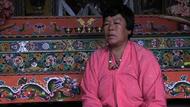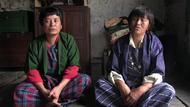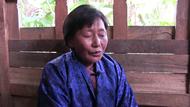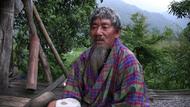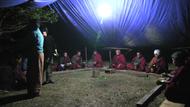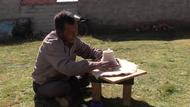Video Overview
An interview with a woodworker from Lhokha about how he learned his craft from his father and his process of learning furniture making and woodcarving. He also describes and names the main tools used in traditional hand carving, discusses the monasteries where he makes shrines, and demonstrates some of his carving techniques.
- Lhokha
- འོ་འདུག་སེ། དང་པོ་དེར་སྟ་གོན་ཆེད་དུ་མར་མི་གང་ག་མ་རུ་འགྲིམ་ཐག་ཉེ་པོ་རེད། ལྟ་ཟེར་གྱི་འདུག་ག ཡང་འོ་འདུག་སེ་བྱས་མ་གིར་ཕྱིན། དང་པོ་དེར་བརྐོས་བསླབ་ཡག་མ་གིར་བསླབས། ཨ་ནི་དེ་ནས་མ་གིར་འགྲེམས་སྟོན་ཅ་སྤྱོད་འདྲ་མི་འདྲ་མང་པ་བཟོས་པ་རེད། འོ་དེར་ཚར་པ་དང་དེའི་རྗེས་ལ་ཁྲ་འབྲུག་དགོན་པར་ཕྱིན། ཁྲ་འབྲུག་དགོན་པར་དེར་བརྐོས་རྒྱག་ཡག་བྱས། ལས་ཀ་འདྲ་མིན་འདྲ་ཞེ་དྲགས་བྱས་འདུག་གMy father learned to carve there. Most of the people study the craft there because that place was nearby. Then he taught the skills and also made all kind of wood furniture and exhibited his works. From there, he later went to Tradruk monastery and started working on monastic projects. Like that, he worked in different places.
- འོ་དེའི་རྗེས་ལ་ལྷ་སར་ཅ་སྤྱོད་འདི་འདྲས་བཟོས། བརྐོས་རྒྱག་ཡག་འདི་འདྲས་འདུག་ག ཡང་འོ་འདྲས་པ་ལགས་གཤགས་མཁན་འདི་འདྲས་སེ་བསླབས་འདུག་ག དེ་ནས་པ་ལགས་གཤགས་མཁན་འོ་འདུག་སེ་བྱས་དེ་ནས་དགོངས་པ་རྫོགས་པའི་འདུག་སེ་བྱས། ལྟ་འོ་འདི་གང་ཟེར་དགོས་ཀྱི་རེད།In Lhasa, my late father built all kinds of furniture and also taught the craft to others at the same time. And he passed away shortly [thereafter].
- འདི་ནས་ང་རའི་དེ་ར་ཅིག་ཞུས་ན་ང་རང་ཡང་ཁྲ་འབྲུག་དགོན་པར་གཅིག་བཟོ་དགོས་ཀྱི་འདུག་ཞེས་ཡང་བརྐོས་བརྒྱབ་བྱས། ང་རང་བརྐོས་པ་ལགས་གཤགས་མཁན་དེ་བསླབས་གནང་འདུག་སེ་བྱས། འདི་བྱས་གང་ལ་གང་འཚམ་གཅིག་ཤེས་པ་རེད་པ། ཡང་ཁྲ་འབྲུག་དགོན་པར་ཡང་འདུག་སེ་བྱས་བརྐོས་རྒྱག་ཀར་ཕྱིན་མཆོད་ཤོམ་འདི་འདྲས་བཟོས། འོ་འདུག་སེ་བྱས་ད་ལྟ་འདི་འདྲས་ཡོད། དེ་ནས་ལྷ་སའང་འགྲོ་ཡག་འདུག་སེ། བརྐོས་འདི་འདྲས་རྒྱག་ཡ་ལྷ་ས་ལ་ཟླ་བ་གསུམ་ཙམ། ཡང་ཟླ་བ་གཉིས་ཙམ་འོ་འདུག་སེ་བྱས་ཐེངས་མ་མང་པོ། ཐེངས་མ་གཉིས་ཙམ་འགྲོ་བ་ཡིན།My father taught me wood carving. Following his steps, I also worked at the Tradruk monastery, building the altar and other furniture for the monastery. I also went to Lhasa twice, and each time I stayed there about two to three months.
- ཡང་དེ་ནས་གང་ཟེར་དགོས་ཀྱི་རེད། ང་ཚོའི་རྣམ་སྲས་གླིང་དགོན་པ་ལའི་ཡང་འོ་འདུག་སེ་བྱས། དགོན་པ་གཞན་པ་ལ་བརྐོས་རྒྱག་ཨེ་འདྲས་འདུག་ག་འོ་དེ་འདྲས་བརྐོས་བརྒྱབ། ཡང་འོ་འདུག་སེ་བྱས་དེའི་རྗེས་ཀྱི་དེ་ང་ཚོའི་གནམ་ལྕགས་གླིང་གཞིས་ཀ་་་འོ་འདིར་ཉམས་བཟོ་གནང་སོང་། འོ་འདིར་བརྐོས་རྒྱག་ག་འོ་འདུག་སེ་འགྲོ་དགོས་འཁེལ་སོང་།At Namsé Ling and other monasteries, I also created similar monastic furniture such as altar and other wood carvings. I also did renovation work at Namchak Ling.
- དང་པོ་ཁྱེད་རང་ཤིང་བཟོ་དགུང་ལོ་ག་དུས་སྦྱངས་གནང་བ་ཡིན་ནམ།At what age did you start learning the craft?
- དང་པོ་ལྟ་ལོ་བྱས་ནས་ལོ་༡༥ ༢༠འདི་པ་བྱས་ནས་ནང་ལ་པ་ལགས་གཤགས་མཁན་གྱིས་འདུག་སེ་བསླབས་གནང་བ་རེད།My father taught me the craft at home when I was about 20.
- ཨཱ་ནི་ལོ་༤༠ཐམ་ལ་པ་ལགས་གཤགས་མཁན་དགོངས་པ་རྫོགས་པ་རེད།When I was about 40, he passed away.
- ཤིང་བཟོ་སྦྱངས་གནས་བྱས་ལོ་ག་ཚོད་ཐོག་ལ་རང་རྐྱ་འཕེར་གྱི་འདུགIn how many years you become an independent wood craftsman?
- ལོ་གསུམ་ཙམ་ཐོག་ལ་རང་རྐྱ་ར་ཅིག་འཕེར་པ་འདྲ་འ་ར་འ་ར་ར་ཅིག ཡང་འགྲོ་ཐུབ་ཙམ་གཅིགIn about three years, I mastered the fundamentals and became wholly independent.
- ཨཱ་ནི་དང་པོ་བཟོས་གནང་ཡག་དེ་ཚོ་གཅིག་འཇམ་གཅིག་རྐྱང་མི་འགྲོ་གཅིག་བརྐོས་མེད་པ་འདི་འདྲས།Then in the beginning, most of what you created must not have been very complicated, is that correct?
- ལྟ་ལག་ཤེས་དང་པོ་སློབ་དུས་འཇམ་ཚང་འདི་འདྲས་འབའ།Yes, I started with simple furniture without complicated decorations on them.
- དང་པོ་དེ་བར་ག་རེ་ག་རེ་བཟོས་གནང་པ་རེད།What were the things you built in the beginning?
- ལྟ་དང་པོ་དེ་པ་ལྟ་ཅ་སྤྱོད་འདི་འདྲས་བྱས། ཆ་སྒམ་འདི་འདྲས། རྒྱ་ཅོག་ཅོག་རྩེ་འདི་འདྲས། འོ་འདི་འདྲས། ལག་ཤེས་སློབ་དུས་དང་པོ་འོ་འདི་འདྲས་བཟོས་པ་རེད། དེ་ནས་འོ་འདི་འདྲས་ཨོ་ཙམ་ཤེས་ཡག་པོ་ཆགས་སུ་ཡང་གཞི་ནས་བརྐོས་གཞི་ནས་པ་ལགས་གཤགས་མཁན་གྱིས་ཡང་འོ་འདུག་སེ་བྱས་སློབས།In the beginning, I started with wooden cupboards, desks, and tables, and so forth. That is how I learned the craft. When I became quite efficient in making these goods, my father taught me the actual wood carving.
- འདའི་བརྐོས་རྒྱག་ཡག་ལ་ལྟ་ལག་ཆ་སྤྱིར་བཏང་བྱས་ན་འདི་འདྲས་ར་ཅིག་ཡོག་རེད།Here what are the primary tools you use for carving?
- ལྟ་བརྐོས་རྒྱག་ཡག་ལ་ལག་ཆ་སྤྱིར་བཏང་མང་ཉུང་བྱས་ནས་འདི་འདྲས་ར་ཅིག་ཡོག་རེད།Generally speaking, these are the tools I use for my creation.
- གཅིག་སྟོན་གནང་དང་། འདུག་སེ་རེ་རེ་བྱས།Can you please show me one by one.
- སྤྱིར་བཏང་འོ་འདི་འདྲས། ཁ་གྲངས་བྱས་ན་རྒྱས་ཚ་ཤོས་དེ་སུམ་ཅུ་ཙམ་ཡོག་རེད་ལྟ།These are the principal tools, and there are about 30 different kinds of tools at the most.
- ཨཱ་ལས་སུམ་ཅུ་ཙམ། གློག་བེད་སྤྱོད་གཏོང་ཡག་ཅས་ཡོག་མ་རེད་པ།I see. Do you use any power tools?
- ལྟ་བརྐོས་རྒྱག་ཡག་རང་དེ་ལྟ་གློག་བེད་སྤྱོད་ཡོག་མ་རེད། ཡང་ལྕགས་སྐུད་ཐོག་ནས་གློག་གི་ཡང་ (Ch.机械) འདི་འདྲས་གཏོང་ཡག་འདུག་གFor actual carving, machines are not useful, except some electric chainsaws.
- ཨ་ལས།I see.
- ལྟ་ད་ལྟ་ཅི་ཆས་སྤྱིར་བཏང་འདི་རེད་སྦ་ཁུག་བཀུག་རྒྱོག་གཅིག་འདུག་ག འོ་འདི་འདྲས་རེད།Like the bent on the container.
- འདི་ཚོ་གང་གར་ག་རེ་ཟེར་གྱི་རེད། ་་་གཙའུ་ཟེར་གྱི་མ་རེད་པ།What are the names of these tools? Is this one called tsau?
- ལགས་འོ།What?
- གཙའུ་ཟེར་གྱི་མ་རེད་པ་འོ་འདི་ཚོར།Is it called tsau?
- གཙའུ་ཟེར་གྱི་མ་རེད། ལྟ་ང་ཚོ་ཤིང་བཟོ་བས་བརྐོས་སག་ཟེར་གྱི་ཡོག་རེད།No, this is not tsau. We call it kösak.
- བརྐོས་སགKösak?
- བརྐོས་སག་ཟེར་གྱི་ཡོག་རེད།Yes, it is called kösak.
- ལྟ་འདའི་འདི་འདྲས་ཁ་ཤས་ཀོང་ཀོང་འདི་འདྲས་བྱས། ཁ་ཤས་ཡང་འདི་འདྲས་ཁ་སྒོར་སྒོར་འདི་འདྲས་བྱས། ལྟ་འདྲ་མི་འདྲ་ཞེ་པོ་ཅིག་ཡོག་རེད་ང་ཚོ་བརྐོས་རྒྱག་མཁན་གྱི་ལག་ཆ། རྒྱས་ཚ་ཤོས་དེ་༣༠ཙམ་འོ་འདི་འདྲས་ཅིག་ཡོག་རེད། ཡང་དེ་ནས་དེ་མིན་ཆུང་ཙག་སླེབས་ཀྱི་རེད།Some of the tools have a shallow gauge. Some of them have round heads like this one. So there are many different types of tools for carving.
- པཱ་ལགས་སྐུ་དུས་ལ་འདི་པར་ཤིང་བཟོ་གནང་མཁན་སྐད་གྲགས་ཆེ་བ་གཅིག་གི་གྲས་མིན་འགྲོYour father must be a famous master wood craftsman in the region, was he?
- ལྟ་ང་ཚོ་ལྷོ་ཁ་བྱས་ན་ལྟ་སྔོན་མ་བྱས་ན་སྐད་གྲགས་ཆེ་བའི་ཁོངས་རེད།In Lhoka region, he was a well-known master craftsman.
- ད་ལྟ་ཡ་གིར་ཁྲ་འབྲུག་ལ་འདི་བཟོས་གནང་ཡོག་རེད་གསུངས་པ་རེད། མུ་ཏིག་གི་སྤྱན་རས་གཟིགས་འདའི་མཆོད་ཤོམ་བཟོས་གནང་ཡོག་རེད།Someone said that at Traduk, your father built the thing that housed the statue of Avalokitesvara with pearls in the monastery.
- འོ་འདི་རེད།That's correct.
- ཨང་མཆོད་ཤོམ་འདི་རེད་པས།Is that the shrine?
- འོ་འདི་མཆོད་ཤོམ་འདི་རེད། འོ་འདི་བཟོ་དུས་བརྐོས་རྒྱག་ཡག་དང་ཐོག་རེད་ལྟ།Yes, it is the shrine he built. When he created it, I also started carving.
- ཨ་ལས་མཉམ་དུ་ཕྱག་རོགས་ལ་ཡོད་པས།Were you his assistant at the time?
- འོ་འདུག་སེ་རེད།Yes, I was.
- ལྟ་མཆོད་ཤོམ་འདི་བཟོས་པར་ག་ཚོད་ཙམ་འགོར་གནང་གི་འདུགHow long did it take to create the shrine?
- མཆོད་གཤོམ་འདི་བཟོས་པར་ལྟ་མིན་ག་རེ་ཟེར་དགོས་ཀྱི་རེད། དུས་ཚོད་ལྟ་མིན་རྒྱས་པོ་དང་རུ་ངར་པོ་འདི་འདྲས་བཟོ་དགོས་ཀྱི་འདུག་ག བྱས་ཙང་མིན་དུས་ཚོད་སྤྱིར་བཏང་མང་ཙམ་འགོར་གྱི་འདུག་ག རེད་ལྟ་འདུག་སེ་བྱས་ཞིབ་པ་ར་ཅིག་བཟོས་ན་ཟླ་བ་དྲུག་ཙམ་འགོར་གྱི་ཡོད་པ་འདྲ།That shrine required a lot of details, and therefore it took a long time. In total, it took about six months to complete that shrine.
- ཨཱ་ནི་འདི་མིན་པའི་དགོན་པ་ག་པར་ག་པར་བཟོས་གནང་བ་རེད། པ་ལགས་ཀྱི་ཕྱག་རྗེས།Which are the other monasteries where he left his marks?
- སྨིན་གྲོལ་གླིང་དགོན་པར་ཡང་མཆོད་གཤོམ། སྨིན་གྲོལ་གླིང་ཏེ་ཆེན་རིན་པོ་ཆེ། ཏེ་ཆེན་རིན་པོ་ཆེ།He also built the altar at Mindröl Ling monastery for Téchen Rinpoche.
- ཏེ་ཆེན་རིན་པོ་ཆེ་ཡི།For Téchen Rinpoche?
- འོ་འདིའི་བཞུགས་སྒྲོམ།Yes, for his throne frames.
- ཨཱ་ནི་བསམ་ཡས་ལ་ཡོག་མ་རེད་པས།Did he builds any wood furniture at Samyé monastery?
- བསམ་ཡས་འདི། བསམ་ཡས་གཙུག་ལག་ཁང་འདི་འདི་འདུག་སེ་བྱས་རྣམ་བདག་སྒོ་གསུམ་ཡོག་རེད་འོ་འདིའི་གཡས་གཡོན་འདའི་འདུག་སེ་བྱས་བརྐོས་བརྒྱབ་ཡོག་རེད།At Samyé, he created some carved works that decorated the two sides of Namdak Gosum.
- སྤྱིར་བཏང་བརྐོས་ཀྱི་རི་མོ་མང་ཆེ་བ་ག་རེ་ག་རེ་བེད་སྤྱོད་གཏོང་གི་ཡོད་ན།Generally speaking, which designs are favorite?
- ལྟ་བསམ་ཡས་དགོན་པའི་དམངས་ཆས་ལྟ་བཀྲ་ཤིས་རྟགས་བརྒྱད་དེ་ཚོ། རི་མོ་ལྟ་རྒྱས་པ་འདུག་ག རྒྱས་ཤོས་ལ་རྟ་སེང་ཁྱུང་འབྲུག་སེམས་ཅན་རྟ་སེང་ཁྱུང་འབྲུག་ཟེར་ན་འདི་ཟེར་གྱི་རེད། རྟ་སེང་ཁྱུང་འབྲུག་ཟེར་ཡག་དེ་འབྲུག རྟ་བྱས། དང་པོ་རྟ་བྱས། གཉིས་པ་སེང་གེ གསུམ་པ་ཁྱུང་། བཞི་པ་འབྲུག འོ་འདུག་སེ་བྱས་སེམས་ཅན་ལྟ་རྒྱས་ཤོས་འོ་འདི་རེད། སེམས་ཅན་འོ་བཞི་པོ་དེ་ལྟ་རྒྱས་ཤོས་འོ་འདི་རེད་ཤགAt Samyé monastery, the popular designs include the eight auspicious signs, and the four animals, namely, horse, snow lion, Garuda, and dragon. These are some of the designs that require a lot of details.
- རྟ་སེང་ལ་སོགས་པ་དེ་གང་ག་བརྒྱབ་ཀྱི་ཡོད་ཀྱི་མ་རེད། གཅིག་མཆོད་ཤོམ་དང་གཅིག་གང་ག་དེ་ཐོབ་ཐང་ཡོག་རེད་པས།It is necessary to create these four animals on every piece like the altar?
- ལྟ་འོ་འདི་ག་རེད་ཟེར་དགོས་ཀྱི་རེད། དགོན་སྡེ་ཁག་དེ་ནས་ཕར་ཟེར་དགོས་ཀྱི་མ་རེད་པས། འོ་འདི་མ་མི་རྒྱས་པོ་འདུག་སེ་བརྒྱབ་དགོས་ཀྱི་འདུག་ག མ་ཟད་ང་ཚོ་ལྟ་སྒེར་གྱི་འདི་འདྲས་མངགས་མཁན་ཚོས་རྒྱས་པ་དགོས་ཟེར་གྱི་འདུག་ག ཡཱ་འོ་འདི་འདྲས་ཟེར་ན་ཡ་འོ་སེ་རྟ་སེང་ཁྱུང་འབྲུག་ཟེར་བ་འདྲ་པོ། ཡང་མཆོད་ཤོམ་རེ་གཉིས་གཅིག་ལ་ཆུང་འདི་འདྲས་རྒྱག་དགོས་ལྟ།For monastic orders, I have to create them. Even some individuals prefer the elaborate carving. In such cases, you create those four animals. For small sized altars, there are smaller designs for their decorations.
- འོག་ལ་སེང་གེ་ཁ་སྤྲོད། དཀྱི་ལ་རྡོ་རྗེ་རྒྱ་གྲམ་འོ་འདུག་སེ་བྱས། ཡང་ཁག་གཅིག་གིས་སྒེར་གྱི་དེ་པ་ནས་འོ་འདི་འདྲས་རྒྱག་རོགས་བྱེད་རྒྱས་པོ་ཞིག་དགོས་ཡོད་སེ་བྱས་འོ་འདུག་སེ། རི་མོ་རྒྱས་པོ་བྱས་འོ་འདུག་སེ་དགོས་སེ་བྱས་ཟེར་གྱི་འདུག་ག ཡང་འོ་འདི་འདྲས་ཟེར་ན་ང་ཚོ་བརྐོས་རྒྱག་མཁན་ངོས་ནས་བཤད་ན་འོ་འདུག་སེ་རྒྱག་ཡག་འོ་འདུག་སེ་ཆགས་ཀྱི་འདུག་གIn the lower portion of a piece, we create designs like the set of the two snow lions facing each other and the crossed-vajra. Some individual clients prefer intricate carving, so accordingly we have to satisfy their demand.
- དང་པོ་བརྐོས་སྐྱོན་དུས་ཙམ་ལ་སྔས་ལ་རི་མོ་གཅིག་བྲིས་དགོས་ཀྱི་རེད་པས་ཁོ། ཤིང་གི་སྒང་ལ་རྟགས་ཤིག་བརྒྱབ་རི་མོ།Before carving, you need to draw the design on the wood surface first, is it like that?
- ལྟ་སྔོན་ལ་ཤོག་བུའི་སྒང་ལ་ཨཱ་ལེ་རི་མོ་གཅིག་བྲིས་དགོས་ཀྱི་རེད། འདི་བྲིས་གཞི་ནས་མར་ཁབ་ཀྱིས་མར་ཁབ་ཚགས་བརྒྱབ། འོ་འདི་ཤིང་སྒང་ལ་མར་གཅིག་བསྡམས། གཞི་ནས་མར་སྣག་ཚས་བྲིས། འདི་ནས་བྲིས་ཚར་སོང་ན་འདི་ཡོག་རེད་སྦག་ཁུག ཕ་གིར་ཡོད། འོ་ཕ་གི་བཤིགས་ནས་ལྕགས་སྐུད་དེ་བཏང་། གཞི་ནས་བརྐོས་བརྒྱབ། འོ་འདུག་སེ་རེད།First, you have to draw the design on paper. Next, you pierce holes on the sketch with a needle. Then you attach the paper to the wooden surface and transfer design on the surface. Next, you use the string saw and cut out the unnecessary part and then start carving.
- ད་ལྟ་འདའི་སྣག་ཚས་བྲིས་གནང་བ་ཨེ་འདྲས་ཡོད་པས། གཅིག་སྟོན་གནང་དང་།Do you have any sample ink drawings here? Can you please show me one?
- འོ་འདི་འདྲས་ཡོད།Yes, I do.
- འདི་རེད།This is it.
- ཨ་ལས། འོ་འདི་འདྲས་རེད་པས།I see, it is like this.
- འོ་འདི་རེད།Right.
- པཱ་ལགས་ཀྱི་དུས་ལ་དགེ་ཕྲུག་ག་ཚོད་བྱུང་ཡོད་དམ།How many students did your father have?
- ལྟ་པཱ་ལགས་ཀྱི་དུས་ལ་དགེ་ཕྲུག་ལྟ་ཁྱོན་བསྡོམས་པའི་དགེ་ཕྲུག་ལྟ་ག་རེ་ཟེར་དགོས་ཀྱི་རེད། སྔས་པ་སྥྱི་ཚོགས་རྙིང་སྐབས་ཀྱི་ཞུ་དགོས་ཀྱི་རེད་པས།Did you mean during the old days (before 1959)?
- འོ་རྙིང་པའི་སྒང་ནས་བྱས་ལྟ།Yes, during those days.
- ལྟ་དགེ་ཕྲུག་བཅུ་གཅིག་བཅུག་གཉིས་ཙམ་འདི་འདྲས་བྱུང་མེད་འགྲོI think he had about eleven to twelve students.
- དེ་ཚོ་གང་ག་ཞུ་གུ་ལག་རྩལ་གང་འདྲ་ཆགས་ཡོད་དམ།Later on, did they all become good craftsmen?
- ལྟ་དེ་ཚོ་གང་ག་དམངས་ཆས་གང་ག་ལག་རྩལ་ཡག་པོ་ཆགས་བསྡད་ཡོག་རེད།Most of them become skilled craftsmen.
- ལུང་པ་ད་གའི་ནང་རེད་པས།Did they come from the same place?
- ལུང་པ་རྣམ་སྲས་གླིང་བྱས། ཡང་རྩེད་ཐང་མ་གིར་མར་བྱས། སྦྲ་ཆེན་བྱས། གྲ་ནང་བྱས། ལུང་པ་གང་ས་གང་ལ་ལྷ་ས་ལའང་ཡོག་རེད།They were from Namsé Ling, Tsétang, Drachen, Dranang, and some of them were even from Lhasa.
- པཱ་ལགས་སྐད་གྲགས་བྱས།That was because of his popularity.
- ལྟ་རེ་གཅིག་རེ་གཉིས་མ་གཞི་དམངས་ཆས་པཱ་ལགས་གཤགས་མཁན་གྱི་དགེ་ཕྲུག་ཡིན་པ་དེ་ཚོ་སྤྱིར་བཏང་ལྟ་གང་ག་ལག་ཤེས་ལག་རྩལ་ཡག་པོ་ཡོད་པ་རྐྱང་རྐྱང་རེད། གཉིས་སྦྱངས་འགྲོ་འདའི་སྦྱངས་འགྲོ་འདིའི་ནང་ལ་གཉིས་ཡོག་རེད་སྤྱིར་བཏང་། ལྟ་དེང་སང་བྱས་ན་ཁོ་རྣམ་པ་གཉིས་ཐུད་ཤོར་(Ch.)གནང་བྱས་འདུག་སེ་བྱས་ཚར་འདུག་ག ལྟ་ཁོང་རྣམ་པ་གཉིས་བགྲེས་ཤོས་ར་ཅིག་རེད། ཡང་དེའི་འོག་འདི་ཚོ་ལྟ་དེང་སང་ལྟ་ཞིང་ལུགས་འདི་པ་འདི་བཟོ་གི་འདུག དེང་སང་ལྟ་ད་ལོ་རེད། དེང་སང་སྣང་དག་ཡོག་མ་རེད།Except one or two, the majority of my father's students became accomplished craftsmen. Two of his foremost students are now retired. They are the senior most students. The rest of them are continuing with their works, and are all doing great.
- ལུང་པ་འདིའི་ནང་དུ་ཤིང་བཟོ་བྱེད་མཁན་ཁྱེད་རང་མིན་པ་ག་ཚོད་ཡོད་ན།In this area, how many artisans doing the same work other than you?
- བཅུ་གཉིས་བཅུ་གསུམ་ཙམ་ཡོག་རེད། བཅུ་གཉིས་བཅུ་གསུམ་ཙམ་ཡོག་རེད། པཱ་ལགས་གཤགས་མཁན་གྱི་དགེ་ཕྲུག་ལྔ་ཙམ་ཡོག་རེད། ལྟ་པཱ་ལགས་དང་པོ་ཡང་དེའི་ཞུ་གུའི་ཞུགས་རྩར་འདའི་ཡང་ངས་འདུག་སེ་བསླབ་ཙམ་བྱས།There are about twelve to thirteen wood craftsmen, and five of them were my father's former students. He taught some of the craftsmen first, and later a few others.
- ལྔ་ཙམ་ཡོག་རེད།About five of them.
- ཨཱ་ནི་ཁྱེད་རང་གི་དུས་ལ་ག་པར་ག་པར་ཕེབས་པ། ལག་རྩལ་དེ་བེད་སྤྱོད་བཏང་བྱས་ཕྱི་ལོགས་ལ་ཡོང་འབབ་བཙལ་ཀ་ཡིན་ནའི་རེད། ཡང་ན་དགོན་སྡེ་ཁག་ལ་འདི་བྱེད་ཡག་ཉམས་བཟོ་དང་འདི་འདྲས་ག་པར་ག་པར་ཕེབས་མྱོང་ཡོད་དམ།To generate income with your skill, can you name the places you visited, including monasteries where you built, and carried out renovations work?
- ང་རའི་ངོས་ནས་ཞུས་པ་ཡིན་ན། དང་པོ་དེར་སྤྱིར་བཏང་ཏོག་ཀོང་རྗེ་ལ་འདུག་སེ་བྱས་འབྲིང་ཙམ་ཞིག་སྒྲོན་ཡོད། འོ་འདི་ནས་མཆོད་ཤོམ་གཅིག་བྱས། ཅོག་རྩེ། ཁྲི་ལྕོག་ཁོའི་ཆ་གཅིག་བྱས། སྣ་ཁ་གསུམ་ར་ཅིག་འོ་འདུག་སེ་བྱས་དང་། གཉིས་པ་ར་དེར་ཁྲ་འབྲུག་དགོན་པར་ཡང་མཆོད་ཤོམ་བཟོ་བར་ཡང་འདུག་སེ་བྱ་གཅིག་སྒྲོན། ཁྲ་འབྲུག་དགོན་པར་པཱ་ལགས་གཤགས་མཁན་གྱི་ཞལ་གདམས་མཆོད་ཤོམ་འདི་བཟོས། དང་ཐོག་ལ་འོ་འདི་ཙམ་བསླབས་གནང་པ་རེད། ཨཱ་ནི་གཉིས་པ་དེ་ཁྲ་འབྲུག་དགོན་པ་གཙུག་ལག་ཁག་བཞེངས་པ་དང་པཱ་ལགས་གཤགས་མཁན་ལྟ་ཁོང་མཆོད་ཤོམ་འདིར། དགོན་པ་ལྟེ་བ་དེ་བཞེངས་ནས་རེད་པ། ཡང་འོ་འདུག་སེ་ཁྲིད་བསྡད་པ་རེད། ཡང་དེ་ནས་སྨིན་གྲོལ་གླིང་ལ་ཡང་འོ་འདུག་སེ་ཡང་མཆོད་ཤོམ་འོ་འདུག་སེ་ཏེ་ཆེན་རིན་པོ་ཆེ་མཆོད་ཤོམ་འོ་འདུག་སེ་བྱས་གཅིག་བཟོ་བ་སླེབས་ཡོད། ཡང་དེའི་རྗེས་ལ་ལྷ་ས་འདི་ནས་བར་དང་། འདི་པ་ཐེངས་གཉིས་ཙམ་ཡང་མཆོད་ཤོམ་དང་ཅ་སྤྱོད་འདི་འདྲས་འདྲ་མིན་འདྲ་འདི་འདྲས་བཟོ་འདུག་ག འོ་འདུག་སེ་ལྷ་ས་འདི་པ་ངས་ཐེངས་མ་གསུམ་ཙམ་འདུག་སེ་འགྲོ ཡང་དེ་མིན་དམངས་ཆས་རྩེད་ཐང་འདི་ནས་མར་རེད། ཡང་རྩེད་ཐང་འདི་ནས་མར་ཡང་དགོས་དུས་ཁྱིམ་ཚང་འདི་འདྲས་ལ་ཡང་ཅ་སྤྱོད་འདི་འདྲས་དང་། ཡང་གཅིག་མཆོད་ཤོམ་འདྲི་འདྲས། ཡང་ཅ་སྤྱོད་འདྲ་མིན་འདྲ་བཟོ་ཡག་འདུག་ག་འོ་འདི་འདྲས་བཟོས་བཞག དམངས་ཆས་ལྟ་རྩེད་ཐང་རྒྱུད་ལ། ཡང་མ་ནས་མར་རྒྱང་རྩེ། རྒྱང་རྩེའི་དེ་ནས་མར་ཡང་འོ་འདུག་སེ་ཤིང་བཟོ་བྱེད་ཀ་འདུག་སེ་འགྲོ་ཡོད། མ་ནས་མར་ཡང་དམངས་ཆས་ལྟ་ཅ་སྤྱོད་འདི་འདྲས་རེད།I first visited Tokongjé first where I created an altar, desk, and two throne tables. Three kinds of goods in total. My next visit was to the Tradruk monastery with my father where we also built the altar. It was there, my father me the taught me the art of carving. That was after the main temple constructed. I also went Mindröl Ling monastery where I created the throne for Téchen Rinpoche. I went to Lhasa three times. Most of my visits were in Tsetang areas where I fulfilled the needs of the individual families, creating all kinds of residential furniture, altar, and other woodworks. I had also been to Gyangtse regions.
- འདིའི་འདི་པ་ཤིང་བཟོ་བྱས་ན་ཤིང་གི་ཡོངས་ཁུངས་གང་ནས་རེད། མང་ཆས་ཀོང་པོ་ནས་རེད་པས།From where you buy the material for wood carving? Is it from Kongpo region?
- ཤིང་ང་ཚོས་ཉོ་ཡོག་ཟེར་དགོས་ཀྱི་རེད་པས། དམངས་ཆས་ལྟ་ཅ་སྤྱོད་འདི་འདྲས་བཟོ་ཡག་ཡིན་ན་ཀོང་པོའི་ཤིང་རེད།For the furniture, we use Kongpo wood.
- བརྐོས་རྒྱག་ཡག་ཤིང་དེ་གང་བྱུང་མ་བྱུང་ཡོང་གི་མ་རེད། ག་རེ་རེད།For intricate wood carvings, you can't use any types of wood. So what kind of wood do you use?
- བརྐོས་རྒྱག་ཡག་ཤིང་དེ་ཡང་ལྟ་ང་ཚོའི་འདི་པ་བྱས་ནས་མ་ཟོམ་ཟེར་གྱི་རེད། ལྟ་ལྷ་སར་སྦྱར་པ་ཟེར་གྱི་རེད།For carving we use here what we call mazom. In Lhasa the call it jarpa (aspen).
- འཇག་པ་རེད་པ།Jarpa?
- འཇག་པ་རེད་པ། ང་ཚོའི་འདི་པ་བྱས་ནས་མ་ཟོམ་ཟེར་གྱི་རེད།Yes, jarpa. Here we call it mazom.
- ཤིང་གཅིག་པ་རེད་པས།Both refer to the same wood.
- ཡིན་ཡག་གཅིག་པ་རེད། ལྟ་ཁོ་རའི་མིང་དེ་ལོག་ཀར།Same material, but different names.
- བཏགས་སྟངས་ལོག་ཀོར་བྱས།They named it differently.
- མིང་བཏགས་སྟངས་ལོག་ཀོར་བྱས་འོ་འདུག་སེ་རེད། ལྟ་ག་རེ་ཟེར་དགོས་ཀྱི་རེད། སོམ་ཟེར་ཡག་དེ་སྤྱིར་བཏང་ཁྲོམ་ལ། སྤྱིར་བཏང་རྒྱ་མིའི་ཁྲོམ་ལ་ཡང་མིན་ཉོ་བྱས་ནས་འདི་ཡོག་རེད་པ། ཡང་རྒྱ་མིའི་མི་ནས་མར་མ་ཟོམ་དེ་ཡོག་མ་རེད། མ་ཟོམ་དེ་ང་ཚོའི་ལུང་པའི་འདི་ནས་མ་ཟོམ་འབེལ་པོ་ཡོག་རེད།Most of the wood materials are purchased from the Chinese dealers in the market. However, they don't have mazom, which we have a lot of here.
- སྟག་པ་འདི་འདྲས་ལ་བརྐོས་རྒྱག་མཁན་ཡོག་མ་རེད་པས།Do you use birth-tree for carving?
- སྟག་པ་འདི་འདྲས་སྤྱིར་བཏང་བཟོ་གི་མེད།Generally, we don't use birth-tree.
- དགོན་པའི་དེ་ཚོ་སྟག་པ་མ་རེད་པ།How about in the monastery?
- དགོན་པའི་དེ་ཚོ་སྟག་པ་མ་རེད། ཡང་བརྐོས་རྒྱག་ཡག་འོ་ལྟ་མ་ཟོམ་ད་ག་རེད།The monastic furniture is not made up of birth-tree. We use mazom for wood carving.
- ལྟ་དེར་བརྐོས་དང་མཉམ་དུ་འདི་སྦྱངས་དགོས་ཀྱི་མེད་འགྲོ་རི་མོ་དེ་སྦྱངས་དགོས་རེད་རས་ཁྱེད་རྣམ་པ་ཚོ།Do you all have to learn how to draw while learning how to carve?
- ཡང་འོ་འདུག་སེ་རི་མོ་སྔོན་ལ། རི་མོ་སྔས་ལ་སྦྱངས། རི་མོ་སྦྱངས། རིམ་པ་ཨོ་ཙམ་ཤེས་སོང་ན་ཨཱ་ནི་གཞི་ནས་ཡང་སོ་སོས་བྲིས་དུས་རི་མོ་གཞི་ནས་བྲིས། གཞི་ནས་ཨཱ་ནི་འདུག་སེ་བྲིས། ལྟ་དེ་འབྲུག་ཀ་རེད། འོ་འདུག་སེ་བྱས་འདའ་ཤིང་འདའ་ལ།Yes, you have the learn how do draw first. Once you mastered it, you can your design like this dragon on the paper.
- བརྐོས་ཤེས་པར་རི་མོ་མ་ཤེས་པ་འདི་འདྲས་ཡོག་རེད་པས།Are there any wood craftsmen who do not know how to draw well?
- འོ་འདི་འདྲས་ལྟ་རེ་གཅིག་རེ་གཉིས་ཡོག་རེད། ལྟ་ད་ལྟ་ངས་པཱ་ལགས་གཤགས་མཁན་ངོས་ནས་ཞུས་ན་བརྐོས་སློབ་གནང་། ཡང་རི་མོའང་སློབ་གནང་། ཆ་ཚང་ཁོ་ར་སློབ་གནང་ཡོག་རེད།There are one or two here. My late father taught me both drawing and carving. He showed me everything.
- ལྟ་ད་ལྟ་ངར་ཡང་དགེ་ཕྲུག་ཡོད། ང་སྤྱིར་བཏང་བརྐོས་བསླབས་པ་མ་ཟད་ངས་རི་མོ་ཡང་ཆ་ཚང་སློབ་ཀྱི་ཡོད། ཡང་ཁ་ཤས་བརྐོས་བསླབས་པ་མ་གཏོགས་རི་མོ་དེ་སློབ་ཀྱི་ཡོག་མ་རེད།I have my students for whom I teach everything. Some masters don't do that. They teach carving alone.
- ལྟ་འདུག་སེ་བྱས་དང་པོ་ལྟ་བརྐོས་རྒྱག་ཡག་འདི་ལ་འོ་རི་མོ་འོ་འདུག་སེ་བྲིས། འདི་གཞི་ནས་འདུག་སུ་ཁབ་ཚགས་བརྒྱབ་བྱས་འདུག་སེ།First of all, you have to draw the design like this. Then create holes in the drawing with a needle for tracing.
- ཨ་ལས་ཁབ་ཀྱི་ཚགས་རྒྱག་དགོས་ཀྱི་རེད་པ། བྲིས་ཚར་སོང་ན།I see. So you punch holes in paper.
- འབའ་ཟོར། འདུག་སེ་བརྒྱབ། འདི་བརྒྱབ་ཚར་བ་དང་། འདི་གཏོང་དགོས་ཀྱི་རེད། ཨཱ་ནི་འདའི་བཏང་འདུག་ག འདིའི་ཟུར་དེར། འོ་འདི་ཚར་བ་དང་གཞི་ནས་འདི་བྱེད་དགོས་ཀྱི་རེད། དེ་བཤགས་བྱས་འདུག་སེ། དེ་ནས་ཁོ་རི་མོའི་ཁ་གཏིང་དེར་རྟ་ཤེས་བཟོ་དགོས་ཀྱི་འདུག་ག ལྟ་རི་མོ་དེ་ཁ་དེར་བྱས། ལྟ་རི་མོ་དེ་འོག་དེར་འདུག་ག ཨཱ་ནི་འོ་འདུག་སེ་བྱས་རྟ་ཤེས་བཟོ་དགོས་ཀྱི་རེད། འདུག་སེ་བྱས་ཧྲོབ་བསྡུས་བྱས་འདུག་སེ་བཟོས་པ་རེད་པ། འདུག་སེ་ཧྲོབ་བསྡུས་བཟོས་ནས་ཡང་རྒྱབ་དེར་འདུག་སེ་བཟོ་དགོས་ཀྱི་རེད། ཧྲོབ་ཙམ་འདུག་སེ།With bazor, we drill like this. After that, we use the string saw. Like this one on the side. After all these, then we start carving and produce a rough work on both sides of the wood.
- འདི་བཟོས་ཚར་པ་དང་། འདུག་སེ་བྱས་ཁོ་ཟུར་དེ་ནས་འདུག་སེ་བལྟས་ནའི་ཕ་ནས་མངོན་གསལ་དོད་པོ་ཞིག་ཡོག་རེད། འདུག་སེ་བྱས་ནའི་མངོན་གསལ་དོད་པོ་ཞིག་ཡོག་རེད། འདི་ནས་ཡར་འདུག་སེ་འདི་ནས་ཡར་བལྟ་དུས་མངོན་གསལ་དོད་པོ་ཞིག་ཡོག་རེད། ཁོ་སྒྲ་དག་པོ་ཆགས་འགྲོ་གི་རེད་པ། འོ་བརྐོས་འོ་འདུག་སེ་རེད།Once you completed all these steps, and if you examine it from all angles, the design on it is visible to you. That is how to create it.
- ལག་ཆ་འདི་ཚོ་གང་ག་བེད་སྤྱོད་གཅིག་རེད་པས་ཚང་མ།Are all these tools have the same purpose?
- ཚང་མ་བེད་སྤྱོད་ལོགས་ཀར་ལོགས་ཀར་རེད། ཁོ་ཁ་ཞེང་ཆེ་ཆུང་ཡོག་རེད།They all have different purposes because their head sizes differ.
- འདི་སྤྱིར་བཏང་ཁ་ཞེང་ཆེ་ཤོས་རེད། འདི་གཉིས། འདི་གཉིས་ཁ་ཞེང་ཆེ་བ་དགོས་དུས་འདི་གཉིས་བརྒྱབ། འདི་བྱེད་དགོས་ཀྱི་རེད།These two are the ones with the large heads. When we need large carving, we use these two.
- ལྟ་དེ་ནས་ཕ་ཤོས་དེ་འདི་རེད། ལྟ་འདི་སྤྱིར་བཏང་མཚམས་མཚམས་ལ་འདི་བེད་སྤྱོད་ཡོག་མ་རེད།This one has the smallest head. We use it occasionally.
- ལྟ་དམངས་ཤས་བེད་སྤྱོད་འདི་རེད། འདི་བྱས། འདི་བྱས། འདི་གས་རེད། ཁྱོན་བསྡོམས་ནས་བཅུ་ཙམ་བེད་སྤྱོད་དམངས་ཆས་གཏོང་གི་རེད།These are some of the frequently used tools. In total, there are about ten of them.
- གང་ག་མིང་གཅིག་པ་རེད་པས་དེ་ཚོ།Do they all have the same name?
- མིང་ལོགས་ཀར་ལོགས་ཀར་རེད། ལྟ་འདའི་ཁ་རིལ་ཟེར་གྱི་རེད།They are different names. This one is called kharil (round head).
- ཁ་རིལ།Kharil?
- ཁ་རིལ་ཟེར་གྱི་རེད།Yes, it is called kharil.
- ལྟ་འདའི་གསེར་སུམ་ཟེར་གྱི་རེད། ལྟ་འདའི་འབའ་ཟོར་ཟེར་གྱི་རེད་ཡང་། མིང་འབའ་ཟོར་ཟེར་གྱི་རེད།This is is called sersum. And this one is bazor.
- འདི་འདྲས་འདི་འདའི་ཡང་ཨི་ཁུང་འབིག་གི་རེད། ལྟ་འདི་དང་དེ་ཆ་རེད།These two have the same purpose, both create holes.
- ལྟ་འདའི་གསེར་སུམ་ཟེར་གྱི་རེད། གསེར་སུམ་ཁ་བྱང་ཆེ་བ་དང་ཆུང་བ་བྱས། ཆེ་ཆུང་གསུམ་དགོས་ཀྱི་འདུག་གThis is also called sersum, and it comes in three different sizes.
- ལྟ་ཁ་རིལ་འདི་འདའི་ཆེ་ཆུང་བཞི་དགོས་ཀྱི་འདུག་གThis kharil comes in four different sizes.
- འདི་འབྲིང་ཚད་དེ་རེད་ཨ་ཅགThis is the medium size.
- འདི་ཕ་ཤོས་དེ་རེད། ཁ་རིལ་འདི།This kharil has the smallest head size.
- འདི་འབྲིང་འདི་བྱས།This one is the middle one.
- ལྟ་ཁ་རིལ་སྦོམ་པ་དེ་འདི་རེད།This kharil is the biggest one.
- ལྟ་འདི་གས་མིང་ཆ་བྱས་སྦོམ་ཕྲ་ཆེ་ཆུང་ཡོག་རེད། འོ་འདི་གས་བཞི་དགོས་ཀྱི་རེད།They all have the same name, but their head sizes differ. We must have these four.
- ལྟ་གསེར་སུམ་དེ་སྦོམ་ཕྲ་གཉིས་དགོས་རེད། ཆེ་བ་གཅིག་དང་ཆུང་བ་གཅིགFor sersum, we have two different sizes. A big one and a small one.
- ལྟ་འདི་ས་བཅོས་ཟེར་བ་རེད། ཁོ་ས་འབྱུག་རྒྱོག་དེ་འདྲས་རེད། འདའི་སྦོམ་ཕྲ་གསུམ་བཞི་ཙམ་ཡོག་རེད།This one is called sachö, and its come in four different sizes.
- ལྟ་འདུག་སེ་སྦོ་ཕྲ་རིམ་པས་བྱས་ན་འདུག་སེ་རེད། འདི་ཕ་ཤོས་བྱས། འདི་སྦོམ་ཤོས་བྱས།Size wise, they are arranged like this. The one on the left is the smallest and other biggest one the other end.
- ལྟ་འདི་ཁོ་ར་ཁ་ལོག་ཟེར་གྱི་རེད། ཡང་ཁོ་ར་ལོགས་ཀར་རེད།This is called khalok. It is a different tool.
- འདི་དང་དེ་མ་གཞི་བཟོ་ལྟ་འདྲ་པོ་བྱས་ཁོ་རའི་ཀོང་ཀོང་འདི་ནས་མར་འདི་བྱས་བཞག་ཡོག་རེད། ལྟ་འདི་ཀྱོག་འདི་ནས་ཡར་འདི་བྱས་བཞག་ཡོག་རེད། ལྟ་འདི་ཁོ་ར་ལོགས་ཀར་རེད།This one and that one look like the same tools.
- ལྟ་འདི་མེ་ཏོག་ཧྲོབ་ཧྲོབ་འདི་འདྲས་འདུག་སེ་བྱས་ཧྲོབ་ཧྲོབ་འདི་འདྲས་དགོས་ཀྱི་འདུག་ག འོ་འདི་འདྲས་ཡིན་ན་འདི་དགོས་ཀྱི་ཡོག་རེད།This one is used for creating rough carving of flowers.
- ལྟ་འདི་སྦོ་ཕྲ་གཉིས་ཡོག་རེད་ཨ་ཅག འདི་ཕ་དེ་བྱས་འདི་སྦོམ་པ་འདི་རེད། ལྟ་ཁོ་གཉིས་ཆ་མིང་བྱས་ན་ཆ་རེད། ཕ་བ་དང་ཕྲ་བ་(སྦོམ་པ་)གཅིགIt comes in two different sizes. This one is thinner one and that one thicker one. They have the same name, but sizes differ.
- ལྟ་ལག་ཆ་ཧྲོབ་བསྡུས་འོ་འདི་འདྲས་རེད།In brief, those are tools we use.
- ད་ལྟ་ཁྱེད་རང་ཁྱིམ་ཚང་ནང་ལ་མི་ག་ཚོད་ཡོད།How many members are there in your family?
- ལྟ་ང་རར་སྤུ་གུ་ལྔ་ཙམ།I have five children.
- ལྔ་ཡོད་པས།Five?
- ལྔ།Yes, five.
- ཨཱ་ནི་སྤུ་གུ་ཚོར་ལག་རྩལ་འདི་བསླབས་ཡོད་པས།Did you teach the craft to them?
- ལྟ་སྤུ་བུ་བུ་གཅིག་དང་བུ་མོ་བཞི་ཡོད། འོ་འདུག་སེ་ཡོད། ལྟ་ད་ལྟ་བུ་དེ་ལོ་བྱས་ན་ལོ་བཅོ་བརྒྱད་རེད། ལྟ་ད་ལྟ་ཨ་ལས་འདའི་ཡོད་པའི་ཨར་པོ་རེད།I have one boy and four girls. My son is eighteen now, and he is a construction worker.
- ལག་རྩལ་འདི་བསླབས་གནང་མེད་པས།Didn't you teach him?
- ལག་རྩལ་ལྟ་རྨང་གཞི་འདི་བསླབས་བཞག་ཡོད།I taught the fundamentals.
- སྤྱིར་བཏང་གི་ལྟ་བརྐོས་མིན་པའི་འཇིམ་འཇིམ་དེ་ཚོ་ཤེས་ཀྱི་རེད་པ།So he knows how to create simple stuff.
- འཇིམ་ཤོས་ལྟ་ཧྲོབ་བསྡུས་ཙམ་འདུག་སེ་བྱས་ཤེས་བསྡད་ཡོག་རེད།He knows how to create simple things.
- གཅིག་ཆ་སྒམ་བཟོ་ཡག རྒྱ་ཅོག་བཟོ་ཡགLike wardrobe and table.
- འོ་འདི་འདྲས་འཇིམ་ས་འདི་འདྲས་སྤྱིར་བཏང་ཧྲོབ་བསྡུས་ཤེས་བསྡད་ཡོག་རེད།Yes, he knows how to create simple things like those.
- བརྐོས་རྒྱག་ཡག་ད་ལྟ་བསླབ་རྒྱུ་རེད་པས།Did you teach him carving?
- བརྐོས་རྒྱག་ཡག་ལྟ་ལྕགས་སྐུད་འདི་གཏོང་ཡག་དེ་སྣང་དག་མེད།Right now he knows how to use this tool, in fact, he is very good with this.
- འདི་བག་ཡག་གི་ཚོད་ར་ཅིག་རེད་པས།Is it for cutting?
- ལྟ་འདི་བག་ཡག་གི་ཚོད་རེད། འོ་འདི་རྩེ་རུ་གཏོང་། འདི་དང་ཨི་ཁུང་འབིག་ཡག་དེ་འདིའི་རྩེ།Yes, it is for cutting. And then this tool is for drilling holes.
- བུ་མོ་ལ་ལྟ་ཤིང་བཟོ་སློབ་ཡག་ལུགས་སྲོལ་ཡོག་མ་རེད་པ།Girls are traditionally not taught carpentry, is that correct?
- ལྟ་བུ་མོ་ང་ཚོ་བྱས་ན་ལྟ་ཡོག་མ་རེད།That's right.
- སྤུ་གུ་གང་ག་ནང་ལ་ཡོད་པས་ད་ལྟ།Are all your children at home?
- ལྟ་སྤུ་བུ་སྤུ་བུ་གཅིག་དེ་སློབ་གྲྭར་ཡོད། དམངས་བཙུགས་སློབ་གྲྭ། ལྟ་རྒན་ཤོས་དེ་བུ་མོ་ཡིན། ལྷ་སར་འདའི་ཡོད། གང་ཟེར་དགོས་ཀྱི་རེད། ཟ་ཁང་ནང་ལ་མི་ལག་འདི་འདྲས་བྱས།One of them is at a public school. The eldest girl is working in a restaurant in Lhasa.
- ད་ལྟ་འདིའི་ནང་ལ་རི་མོ་ག་རེ་ག་རེ་བྲིས་གནང་ཡོད།What are those designs shown in this piece?
- ལྟ་འདི་དཀྱིལ་དེ་འདོད་ཡོན་སྣ་ལྔ་རེད། འདི་དཀྱིལ་དེ་འདོད་ཡོན་སྣ་ལྔ་བྱས། ལྟ་འདི་གླང་ཆེན་རེད། འདི་ལྟ་རེད། ལྟ་གླང་ཆེན་སྒལ་བའི་སྒང་ནོར་བུ་འོད་འབར་བརྒྱབ་རྒྱོག་རེད། རྟའི་སྒལ་པའི་སྒང་ལ་ནོར་བུ་འོད་འབར་རེད།At the center, we have the five types of sensory enjoyment (mirror, lute, incense, fruit, and silk). This one is a horse, and it carries a glowing jewel on its back.
- ལག་ཆ་འདི་ཚོ་གང་འདྲ་བེད་སྤྱོད་གཏོང་དགོས་ཀྱི་རེད་ཁྱེད་རང་བཏང་གནང་དང་།Can you please show how to use the tool.
- ལྟ་ཨ་ཅག་ཁ་རིལ་ཟེར་ཡག་དེ་འདའི་མེ་ཏོག་འདའི་འདུག་སེ་ཡང་འདུག་སེ་གཏོང་དགོས་ཀྱི་རེད། ཁ་རིལ་འདི།The kharil is used for carving out flowers like this.
- རི་མོ་མེ་ཏོག་དང་སྒོར་སྒོར་འོ་འདི་འདྲས་ལ་བེད་སྤྱོད་གཏོང་དགོས་ཀྱི་འདུག་གFor flowers and other circular designs, we use kharil.
- ལྟ་འདི་གསེར་སུམ་འདི་འདའི་ལོ་མ་རེད། མེ་ཏོག་འདའི་བྱས། ལོ་མ་གཅིག་འདའི་བྱས། ལོ་མ་གཅིག་འདུག་སེ་བྱས་སླེབས་འདུག་ག འོ་འདི་ཡང་ཁོ་ར་དཀྱིལ་དེར་འདུག་སེ་ལོ་མའི།Sersum is used for creating leaves. This is a flower. There is one leaf here and another one there. This tool is useful for caring midrib of a leaf. Like this.
- གསེར་སུམ་འདི་ལོ་མ་བཟོ་དུས་བེད་སྤྱོད་གཏོང་དགོས་འདུག་ག ལྟ་འདི་ས་གཅོད་རེད།Sersum is useful for creating leaves. This one is called sachö.
- ལྟ་ཁྱེད་རང་བརྐོས་འདི་བསྐྱོན་བྱས་ལོ་ག་ཚོད་ཐད་སོང་ལོ། བརྐོས་རང་བསྐྱོན་བྱས།For carving alone, how many years you spent so far?
- བརྐོས་རང་ལྟ་ཤིང་བཟོ་འདི་ནས་ལོ་༣༠ནས་ལྟ་ཤིང་བཟོ་ལོ། བྱས་ཙང་བརྐོས་རང་དེ་ལོ་༣༠བྱས་༤༠། ༤༠ནས་ད་ལྟ་ལོ་འགྲོ་གི་ཡོག་རེད་༤༨བྱས། འདིའི་བར་ལོ་ག་ཚོད་ཙམ་ཕྱིན་ནམ།I started working as a carpenter from the age of 30. And I began carving from the age of 40 till 48.
- ༤༠ནས་སྦྱངས་གནང་པས།Did you start at 40?
- ༤༠ནས།Yes, from 40 onward.
- ད་ལྟ་བར་དུ། ལོ་༨ཙམ།Till now it is about eight years then.
- ལོ་༨འོ། འོ་རེད། ལོ་༨ཙམ་ཞིགYes, about eight years.
- ཨཱ་ནི་པཱ་ལགས་གཤགས་བྱས་ཞེ་དྲགས་འགྲོ་གི་ཡོག་མེད་པ།Then you father passed away not long ago?
- པཱ་ལགས་དགུང་ལོ་༧༣ལ་གཤགས་པ་རེད།My father passed away age the age of 73.
- པཱ་ལགས་ཡོད་དུས་ལྟ་ཤིང་བཟོའི་ལག་རྩལ་འདའི་ཡ་ཉི་མ་ལ་མི་ལག་འདི་འདྲས་བྱས་ན་ཡོང་འབབ་ཡག་པོ་མེད་འགྲོWas your father must be paid well for his work?
- ལྟ་ག་རེ་ཟེར་དགོས་རེད། ཕྱི་ལ་སྤྱིར་བཏང་ལྷ་ས་འདི་འདྲས་ཕྱིན་ན་དེ་དུས་ཙམ་ལ་ཞེ་དྲགས་སེ། ལྟ་དེང་སང་འདྲ་པོ་གླ་ཆ་མཐོ་པོ་ཨེ་འདྲས་ཡོག་མ་རེད། མཐོ་ཤོས་ལས་སྒོར་མོ་༦ཙམ་རེད། ༥ཙམ་རེད། འདི་འདྲས་རེད།How should I put it? In my father's das, he was not getting that much even if he went to Lhasa. About five or six yuan per day.
- ཨཱ་ནི་མཆོད་ཤོམ་འདྲ་པོ་ཆེ་ཨེ་འདྲ་བཟོས་གནང་ལ་སྔས་ནས་ཅ་ལག་ལ་གོང་བརྒྱབ་ཀྱི་རེད་པས།For a large size order, such as an shrine, did you fix the price first?
- ལྟ་ཁ་ཤས་ཡང་འོ་འདུག་སེ་བྱས་ཡང་ཅ་ལག་ཁོ་རར་གོང་བརྒྱབ། ཏིང་ཙོག་(Ch.)བྱས་ན་ཡང་། དེང་སང་ཁག་ཅིག་འོ་འདུག་སེ་བྱེད་ཀྱི་ཡོད།Yes, the prices for customer orders are predetermined.
- ཤིན་དམངས་ཆས་ཕར་མི་ལག་འདི་འདྲས་སེ།In most cases, I work as hired-hand.
- ཁྱེད་རང་པཱ་ལགས་རི་མོ་འདི་ལག་རྩལ་འདི་ཆ་ཚང་སྦྱངས་གནང་པས།Did you learn everything things from your father?
- ཆ་ཚང་བཟོ་ལྟ་ལྟ་སྐབས་དེ་དུས་ཙམ་ལ་པཱ་ལགས་སྐབས་བརྐོས་མདོར་བསྡུས་དེ་འབྱུང་དེ་ལྟ་རྦད་དེ་ཡར་བླུགས་གནང་པའི་བཟོ་ལྟ་ཞིག་འོ་འདུག་སེ་རེད། ལྟ་མ་གཞི་བྱས་ན་པཱ་ལགས་དགུང་ལོ་འདི་བྱས་ན་ལྟ་ཆེ་བ་ཉི་ཤུ་ཐམ་པ་ཡིན། མི་གཞི་དགོང་ལོ་མཐོ་པོ་རེད། ཡིན་ནའི་ལྟ་ང་རའི་ལག་རྩལ་ཤེས་ཡག་བྱས་ནས་ལྟ་ལོ་གཅིག་གཉིས་ཙམ་བཞུགས་ན་ལག་རྩལ་ད་དུང་འདི་ཇེ་རུ་འགྲོ་གི་རེད་པས། འདའི་ཡིན་ནའི་ཐབས་ཤེས་ཡོག་མ་རེད། པཱ་ལགས་སྐུ་ཚེ་འདི་འདྲ་གཅིག་རེད་པ། ང་རའི་བསམ་བློ་ནང་བྱས་ན་ལོ་གཉིས་གསུམ་ཙམ་བཞུགས་ན་ལག་རྩལ་ད་དུང་དེ་ཇེ་རུ་འོ་འདི་འདྲས་ལྟ་རེ་བ་བྱས་ཡོད།When he was there, I learned almost everything he taught me. And he taught me all the fundamentals of carving. I hoped that he would live at least another two to three years so that I could also master the craft thoroughly. But you have no choice on that matter.
- རི་མོ་འདིའི་ནང་ལ་སྣ་ཁ་ག་ཚོད་ཡོད་དམ་བརྐོས་ལ།How many design objects are there in a carved piece?
- ལྟ་སྣ་ཆ་འདྲ་མིན་འདྲ་སྣ་ཚོགས་ཡོག་རེད་དཱ། ལོ་མ་ལྟ་ཆ་བཞག་ན་ཁག་གསུམ་ཁག་བཞི་ལྔ་ཙམ་ཡོག་རེད།There are many. For example, there are three to four types of designs for leaves.
- ལོ་མ་གཅིག་ལ།For a single leaf?
- བཟོ་ལྟ་ལོགས་ཀར། ལྟ་མེ་ཏོག་ལ་ཆ་བཞག་ནའི་ཁག་ལྔ་དྲུག་གིས་ཚད་ཀྱི་ཡོག་མ་རེད།Yes, different leaf shapes. For a flower, there are more than five or six types of designs.
- ཨཱ་ནི་དེ་ཚོ་ལོ་མ་དང་བཟོ་ལྟ་མི་འདྲ་ལ་ལག་ཆ་བེད་སྤྱོད་གཏོང་སྟངས་ལོགས་ཀར་རེད་པས།So depending on the designs, do you use different tools to create them?
- ཡང་མེ་ཏོག་ཁོ་ར་བཟོ་ལྟ་ལོགས་ཀར། ལོ་མ་བཟོ་ལྟ་ལོགས་ཀར་ཡང་ལྟ་ལག་ཆ་བཟོ་ལྟ་ལོགས་ཀར།Depending on the shapes of flowers or leaves, we use different sized tools to carve them.
- ལྟ་མེ་ཏོག་ཁ་རིལ་འདའི་ཆ་བཞག་ནའི་སྦོམ་ཕྲ་ཆེ་ཆུང་བཞི་ཙམ་འདུག་ག ཁ་རིལ་འདི་བྱས། ལྟ་ཁ་རིལ་འདི་ལྟ་མེ་ཏོག་བྱས་ན་འདིའི་སྒོར་སྒོར་འདི་ལ་འདུག་སེ་རྒྱག་ཡགIn case of this kharil for carving flowers, it comes in four different sizes. And it is used for creating the circular shape of the flower petals
- ལྟ་ལག་ཅ་འདི་མེ་ཏོག་འོ་འདི་འདྲས་འདིར་ཡང་འདི་འདུག་སེ་བྱས། ཡང་མེ་ཏོག་བཟོ་ལྟ་ལོགས་ཀར་འདུག སྦོམ་ཕྲ་སྣ་མིན་སྣ་ཚོགས་ཡོག་རེད་པ། སྦོམ་ཕྲ་ཆེ་འདའི་ཡང་ཁོ་ཆེ་འདི་རྒྱག་དགོས་རེད་པ། ཆུང་བ་དེར་ཆུང་བ་དེ་རྒྱགSo this tool is used for carving flowers like this. For different flower designs, we use different sizes of the same type of tool.
- ལྟ་མེ་ཏོག་འདའི་འདིའི་ནང་ཁུག་དེར་གཅིག་ཡོག་རེད། ཆུང་ཆུང་ཞིག འོ་འདིར་ཡང་འདི་ཁ་རིལ་ཕ་བ་དེ་འདུག་སེ་བྱས། འདུག་སེ།There is a small shape inside this. For that, we use small sized kharil.
- ལག་ཆ་འོ་འདི་མེ་ཏོག་འདི་ཆུང་ཆུང་འདིའི་ནང་ཁུལ་འདིར་རྒྱག་ཡག་རེད།This tool is used for carving small flowers inside it.
- ལག་ཆ་འདི། འདི་ཁམ་བུ་རེད། དུས་གསུམ་ཁམ་བུ། འདི་དར་ལྕགས་རེད། འདོད་ཡོན་སྣ་ལྔའི་དར་ལྕགས་བྱས་འདུག་སེ་བྱས།This one is peach. And that dripping cloth is part of the five types of [sensory] enjoyment.
- འདི་ཁམ་བུ་བྱས། འདི་མེ་ལོང་བྱས། འདི་སྤོས་ཆེན་བྱས། སྣ་ཁ་ལྔ་ཡོག་རེད། བྱས་ཙང་གཙོ་བོ་འདི་བྱས་ཨཱ་ནི་འདི་ནས་སྣ་ཁ་ལྔ་བྱས་འོ་འདུག་སེ་རེད། ལྟ་ལག་ཆ་འོ་འདིའི་ཁམ་བུ་འདི་དང་དར་ལྕགས་འདི་རི་མོ་ཆེ་ཆུང་འདིར་ཏག་ཏག་བྱེད་ཀྱི་ཡོག་རེད།This one is a peach. This is the mirror. And this is incense. There are five qualities. The main object is this one. And the tool I am using is a perfect size for carving the peach and the cloth.
- ལྟ་འདི་གསེར་སུམ་རེད། གསེར་སུམ་ཕ་བ་འདི་རེད། འདི་ལོ་མ་འདི་ལོ་མ་ཆུང་བ་འདི་འདི་འདུག་སེ། ལྟ་འདི་ཁ་རིལ་འབྲིང་བ་འདི་རེད། འདིའི་ནང་ཁུལ་འདིར་ཡང་འདུག་སེ།The one I am using is sersum, and it is the thin one. It is suitable for creating small leaves. Especially good creating those embedded inside.
- ལྟ་འདི་ཨ་ཅག་མེ་ཏོག་འདའི།This tool if for that flower.
- ཤིང་འདི་སྦྱར་པ་རེད་པས།Is it aspen wood?
- འདི་སྦྱར་པ་རེད། བརྐོས་རྒྱག་ཡག་ལ་སྦྱར་པ་འདི་ཡག་ཤོས་རེད་འདུག་གYes, it is aspen wood. For carving, this type of wood is best.
- ད་རེས་འདི་ག་རེ་བཟོས་གནང་ཡག་ཡིན་པ།What are you going to create today?
- འདི་ཨ་ཅག་འདི་མཆོད་གཤོམ། མཆོད་ཤོམ་མདུན་གྱི་སྒྲོམ་སྐྱོར་འདི་རེད།I am working on a shrine, and this is for its front fence.
- བརྐོས་བརྒྱབ་ཚར་པ་ཨེ་འདྲས་ཡོད་པས།Do you have finished works?
- བརྐོས་བརྒྱབ་ཚར་པ་ཡོད།Yes, I have.
- ལྟ་འདི་ཧྲོབ་བསྡུས་འདི་བཟོས་པ་རེད།This one is the rough work.
- བསྲེག་བཅད་དེ་ཨ་ཅག་ལག་ཆ་འདི་འབྲུག་བཟོ་དུས་ཙམ་ལ་འདི་གཏོང་དགོས་ཀྱི་འདུག་ག་སྔས་ལ།This tool is used for carving dragon. Like this one.
- འདི་ག་པར་བཏང་ཡག་རེད།Where are you going put it?
- འདི་མཆོད་ཤོམ་གི་གཡས་གཡོན་འདའ་རེད། འདུག་སེ། འདི་གཞོགས་གཡས་འདིར་ཟེར་བ་རེད་པ།This is a side decoration for an altar. Like this. This one goes to the right side.
- འདིའི་སྒང་ལ་རི་མོ་ག་རེ་ཡོག་རེད།What are those designs on this piece?
- འདི་འབྲུག་ཁ་སྤྲོད་རེད། འབྲུག་ཁ་སྤྲོད་བྱས་ནས་འབྲུག་གི་གཟུགས་པོ་འདུག་སེ་བྱས།This is a dragon set where the two dragons face each other.
- འདི་བུམ་པ་བྱས། བུམ་པའི་ནང་ནས་མེ་ཏོག་དང་ལོ་མ་དཀར་ཡོལ་ནས་འདི་ནས་ཡར་འདུག་སེ་སླེབས་པ་རེད།This is a vase, out of which, the flowers and their leaves spread upward.
- འབྲུག་གི་གཟུགས་པོ་འདི་འདི་ནས་ཕར་འདུག་སེ་བྱས། འབྲུག་གི་གཟུགས་པོ་འདི་འདི་ནས་ཚུར་འདི་ནས་ཚུར་སླེབས་ཀྱི་རེད། ལྟ་ད་ལྟ་འདའི་ཨ་ལས་སོག་མ་ཡོང་བར།The dragon is winding this way and encircling around the pole.
- རྒྱབ་ལོག་འདི་ག་རེད།What is that on the back?
- འབྲུག་གི་གཟུགས་པོ་རེད།It is the part of the dragon's body.
- འོ་འདུག་སེ་བྱས་འདའི་སྐོར་ར་བརྒྱབ་བསྡད་ཡོག་རེད། ལྟ་འདི་ནས་འདའི་འདུག་སེ་བྱས་གཏོང་ཡག་རེད། འདི་ཟུར་འདི་ནས་འདུག་སེ། འདི་འདི་ནས་འདུག་སེ་བྱས་སྒང་དེར་འདའི་སྐོར་ར་བརྒྱབ་བསྡད་ཡོག་རེད་ཤིང་དེར། འདའི་སྐོར་ར་བརྒྱབ། ཡང་འདི་ནས་འདའི་འདུག་སེ་བྱས་སྐོར་ར་བརྒྱབ་ནས་འདི་ནས་འདུག་སེ་བྱས་འདིའི་སྒང་འདའི་འདུག་སེ་བརྒྱབ་ཡོག་རེད། ཨཱ་ནི་འདུག་སེ་བྱས་སླེབས།Like this, it is circling around the wooden pole while moving upward.
 Loading ...
Loading ... 